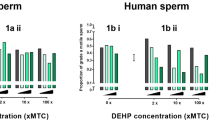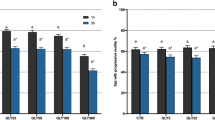Abstract
In vitro effects of lead (Pb) on ram (Ovis aries) spermatozoa were studied to establish a threshold level that affects sperm function. Spermatozoa were incubated between 15 and 180 min with Pb concentrations ranging from 0 to 5,000 ng/mL. Sperm motility, acrosome integrity, membrane functionality and sperm viability were all negatively affected by Pb and incubation time. Acrosome integrity was linearly affected by Pb levels at an incubation time of 30 min, and 50 ng/mL was the lowest Pb level producing such effect. These experimental conditions can be appropriate for in vitro studies of the mechanisms of action of Pb on spermatozoa.


Similar content being viewed by others
References
Alexaki E, Samara C, Alexopoulus C, Tsafaris F (1990) Detection of lead in blood, seminal plasma, and spermatozoa of bulls. Effect in vitro of lead acetate on sperm motility. Bull Environ Contam Toxicol 45:824–828
Apostoli P, Kiss P, Porru S, Bonde JP, Vanhoorne M (1998) Male reproductive toxicity of lead in animals and humans. ASCLEPIOS Study Group. Occup Environ Med 55:364–367
Auger J (1997) Evolution of male fertility in the last twenty years. Contracept Fertil Sex 25:524–529
Benoff S, Centola G, Millan C, Napolitano B (2003a) Increased seminal plasma lead levels adversely affect the fertility potential of sperm in IVF. Hum Reprod 2:374–383
Benoff S, Hurley IR, Millan C, Napolitano B, Centola GM (2003b) Seminal lead concentrations negatively affects outcomes of artificial insemination. Fertil Steril 80:517–525
Castellanos P, Mateo R, Reglero MM, Esteso MC, Fernández-Santos MR, Garde JJ (2008) In vitro effects of lead on fatty acid composition, oxidative stress biomarkers and quality of ram spermatozoa. Toxicol Environ Chem 90:1163–1175
Castellanos P, Reglero MM, Taggart MA, Mateo R (2010) Changes in fatty acid profiles in testis and spermatozoa of red deer exposed to metal pollution. Reprod Toxicol 29:346–352
Deonandan R, Jaleal M (2012) Global decline in semen quality: ignoring the developing world introduces selection bias. Int J Gen Med 5:303–306
Evans G, Maxwell WMC (1987) Salamon’s artificial insemination of sheep and goats. Butterworths, Sidney
Foote RH (1999) Fertility of rabbit sperm exposed in vitro to cadmium and lead. Reprod Toxicol 13:443–449
Garde JJ, Ortiz N, Garcia A, Gallego L, Landete T (1998) Post mortem assessment of sperm characteristics of the red deer during the breading season. Arch Androl 41:195–202
Hernández-Ochoa I, Garcia Vargas G, López-Carrillo L, Rubio-Andrade M (2005) Low lead environmental exposure alters semen quality and sperm chromatin condensation in northern Mexico. Reprod Toxicol 20:221–228
Hsu P, Hsu C, Liu M, Chen L, Guo YL (1998) Lead induced changes in spermatozoa function and metabolism. J Toxicol Environ Health A 55:45–64
Johansson L (1989) Premature acrosome reaction in spermatozoa from lead-exposed mice. Toxicology 54:151–162
Pant N, Upadhyay G, Pandey S, Mathur N (2003) Lead and cadmium concentration in the seminal plasma of men in the general population: correlation with the sperm quality. Reprod Toxicol 17:447–450
Reglero MM, Taggart MA, Castellanos P, Mateo R (2009) Reduced sperm quality in relation to oxidative stress in red deer from a lead mining area. Environ Pollut 157:2209–2215
Ronis MJ, Badger TM, Shema SJ, Roberson PK, Shaikh F (1996) Reproductive toxicity and growth effects in rats exposed to lead at different periods during development. Toxicol Appl Pharmacol 136:361–371
Selvaraju S, Nandi S, Gupta PS, Ravindra JP (2011) Effects of heavy metals and pesticides on buffalo (Bubalus bubalis) spermatozoa functions in vitro. Reprod Domest Anim 46:807–813
Skakkebaek NE, Jørgensen N, Main KM, Rajpert-De Meyts E, Leffers H, Andersson AM, Juul A, Carlsen E, Mortensen GK, Jensen TK, Toppari J (2006) Is human fecundity declining? Int J Androl 29:2–11
Tamuli M, Watson PP (1994) Use of a simple staining technique to distinguish acrosomal changes in the live sperm sub population. Anim Reprod Sci 35:247–254
Telisman S, Colak B, Pizent A, Jurasovic J, Cvitkovic P (2007) Reproductive toxicity of low-level lead exposure in men. Environ Res 105:256–266
Xu D-X, Shen H-M, Zhu Q-X, Chua L, Wang QN, Chia SE, Ong CN (2003) The associations among semen quality, oxidative DNA-damage in human spermatozoa and concentrations of cadmium, lead and selenium in seminal plasma. Mutat Res 534:155–163
Acknowledgments
The authors thank P. Camarero, M. Martinez-Haro for their technical assistance. CERSYRA personnel are also acknowledged for providing facilities and animals for the experiment. This study has been funded by the Department of Education and Science of the Junta de Comunidades de Castilla-La Mancha under projects PCC-05-004-2 and PCI08-0096-1295.
Author information
Authors and Affiliations
Corresponding author
Rights and permissions
About this article
Cite this article
Castellanos, P., Maroto-Morales, A., García-Álvarez, O. et al. Identification of Optimal Concentrations and Incubation Times for the Study of In Vitro Effects of Pb in Ram Spermatozoa. Bull Environ Contam Toxicol 91, 197–201 (2013). https://doi.org/10.1007/s00128-013-1032-5
Received:
Accepted:
Published:
Issue Date:
DOI: https://doi.org/10.1007/s00128-013-1032-5




